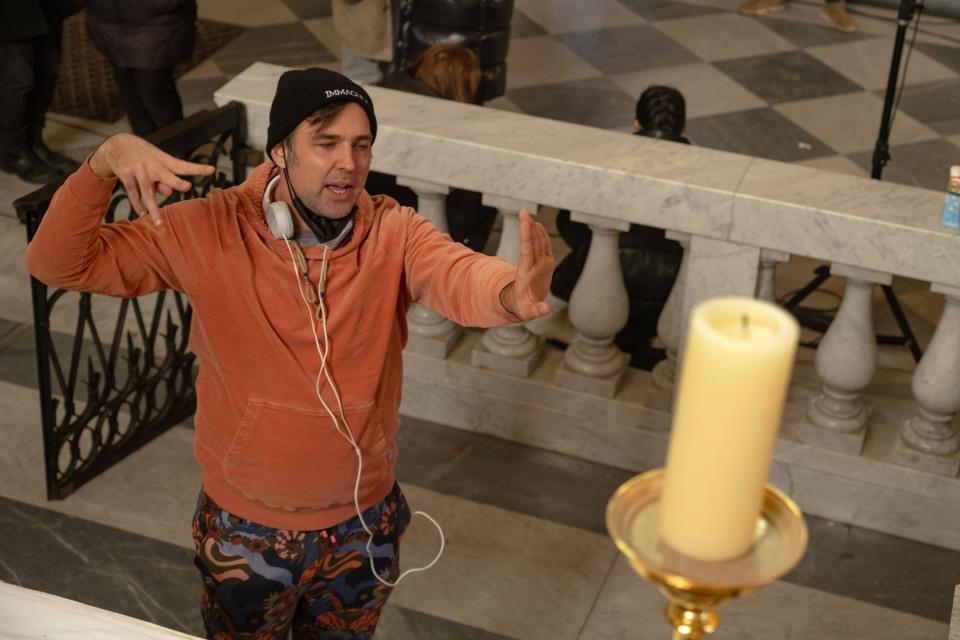‘Immaculate’: Inside the Film’s Gnarly Ending and Bloody Sydney Sweeney’s Scream Into the Void

- Oops!Something went wrong.Please try again later.
[Editor’s note: The following story contains major spoilers for the ending of “Immaculate.”]
If you’ve been praying to the genre movie gods for a pregnant final girl to wreak bloody havoc in the last act of a horror movie, “Immaculate” has answered you.
More from IndieWire
While the first hour or so of director Michael Mohan’s “Immaculate” is laden with familiar jump scares and ominous Catholic portent, all hell breaks loose in the last act. Sister Cecilia (Sydney Sweeney), who embraced religious piety after surviving nearly drowning in a frozen lake as a young girl, is the new nun in town at an exclusive Roman convent that doubles as a hospice care center for dying nuns in their last days. Despite coming to the convent a virgin, Cecilia is stunned to discover she’s pregnant.
That’s because Father Sal Tedeschi, a former geneticist before he became a priest, has been running DNA experiments for decades on the sisters, with Cecilia his first test subject to carry a baby to term. She catches on to the religious plot — that her baby will somehow either save the world or end it as a kind of newfangled Jesus — killing mother superior (Dora Romano) with a crucifix, strangling the cardinal (Giorgio Colangeli), and setting Father Tedeschi’s laboratory ablaze with ethanol.
Almost escaping through a network of underground catacombs, she’s accosted by a severely burned Father Tedeschi (how he survived the lab fire, who knows), only to impale him with a crucifix nail. (It’s during this scene that Sweeney got fake blood in her eye but told the filmmakers to keep rolling anyway despite being visibly pained, and it’s a take that ends up in the finished movie.) She escapes, “The Descent”-style, through a hole in the ground, then gruesomely gives birth, rips the umbilical cord off with her teeth, and is horrified by the sight of her baby. She lets out a soul-shattering primal scream, grabs a rock, and smashes the infant, obviously deformed but seen out of focus in the back of the frame, to death with a single thud. Cut to black, roll credits.
From Cecilia’s final escape through the murder of her child, the ending of “Immaculate” unfolds in a single take that lasts probably five minutes. “I am going to take credit for this ending,” filmmaker Mohan, who directed “Immaculate” from a long-gestating script by Andrew Lobel, told IndieWire. “When I first read the script, it did not have this ending, and when I closed the script, I had the vision for what this needed to be. It is my proudest directorial moment because it is exactly how I pictured it. The way the camera moves, the reveal of whatever [the baby] might be, sort of out of focus in the background as she picks up the rock, it is beat for beat everything I dreamed of.”

Sweeney also produced “Immaculate” and brought the script, which she auditioned for as a teenager in an early iteration of the story, to Mohan’s attention after they worked together on his erotic thriller “The Voyeurs.” “We would stay up super late trying to prep for the next day and try to take all the things that we learned about the other actors, what we learned about how fast the crew worked, to try to really maximize what we had,” said Mohan, who shot the film with cinematographer Elisha Christian and the rest of the crew and cast on location in and around Rome. (The budget was in the mid-seven figures.)
“When we got that scene, we both had a very clear understanding of what it needed to be, and we didn’t rehearse it. We simply mapped out the blocking, and we just sort of let it rip,” he said. “What you see in the movie is take one. We did a couple of other takes, but when we saw that first take, we knew she had nailed it. We knew that our camera operator Armando [Avallone] had nailed it.”
The umbilical cord and the baby itself were all created with practical effects and special effects makeup, as Mohan wanted to keep the horrors of “Immaculate” as handmade as possible.
“We did have a puppet that was with a series of tubes buried in the ground that gave it that little bit of motion,” Mohan said of the baby, “so it wasn’t just a stagnant thing. It was a practical thing that was there on the day that was completely covered in blood and viscera. Same goes for the umbilical cord. Every bit of it was practical.”
Supervised by makeup department head Federica Emidi, the umbilical cord was first modeled out of wax to create a mold, with 10 replicas made of pastry products and food coloring. As for the baby, Mohan said, “The goal was never to show it. Whatever people imagine is going to be 10 times more terrifying than what I show them. Also, that creature or baby or whatever you want to call it, the allegorical implications are so much stronger if you don’t actually see it. Maybe that creature actually represents an idea, and what that idea is will be personal to each person who sees the movie.”
Best of IndieWire
Sign up for Indiewire's Newsletter. For the latest news, follow us on Facebook, Twitter, and Instagram.

